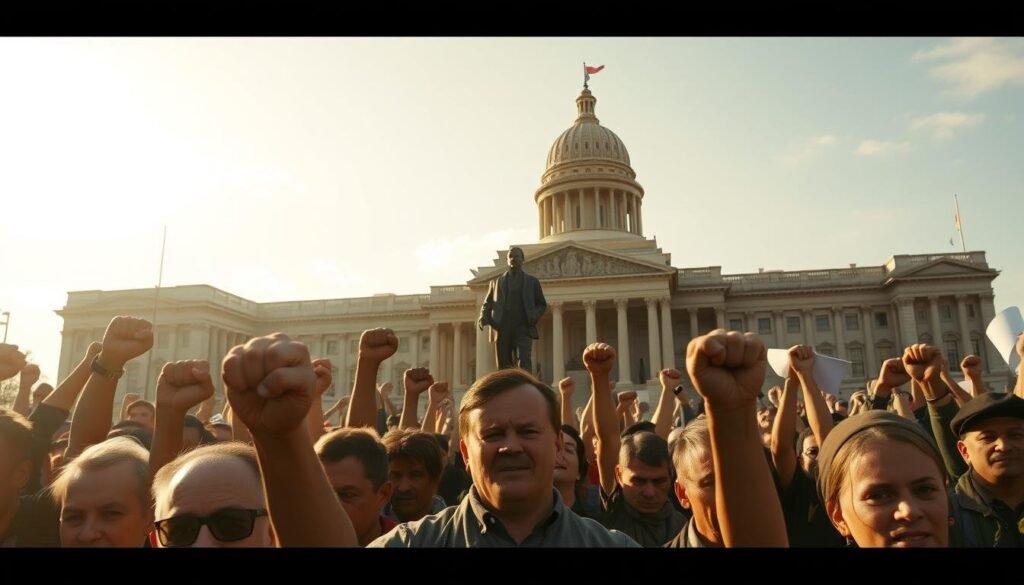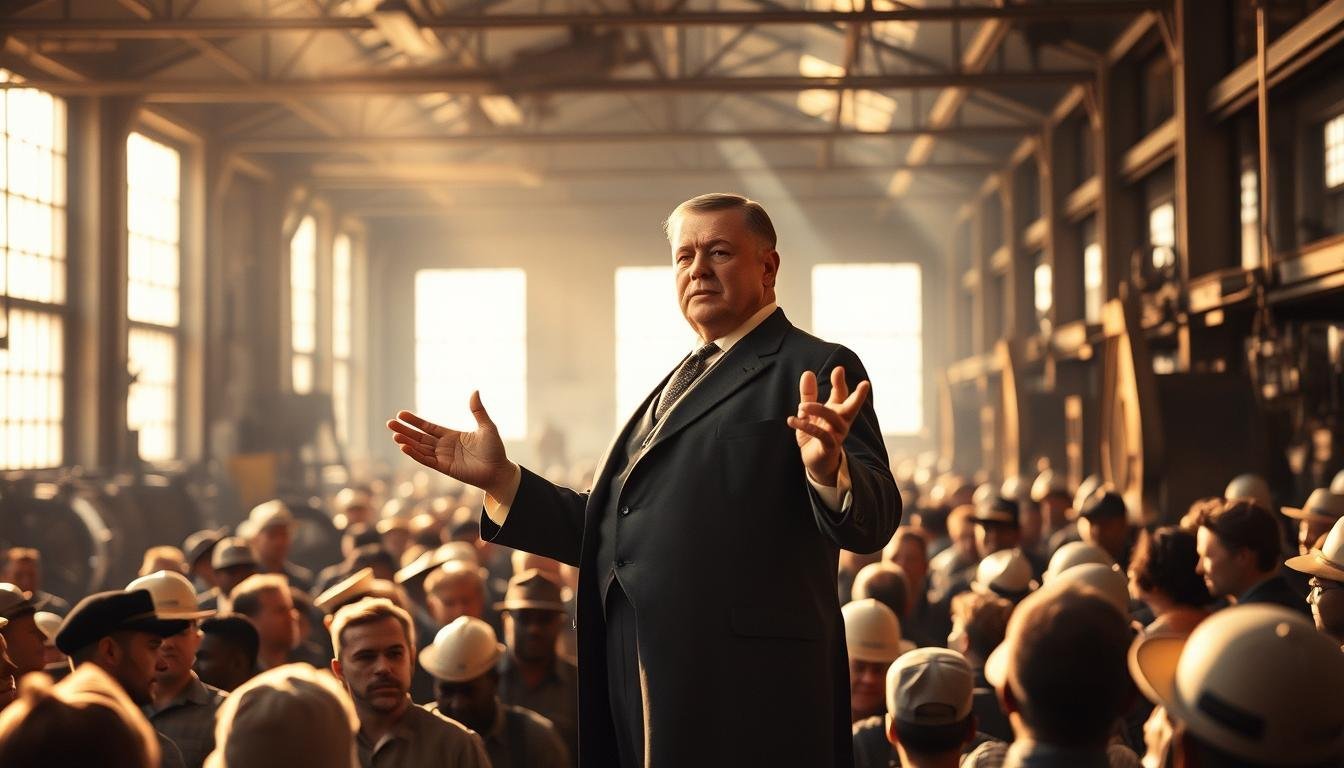Theodore Roosevelt’s Position on Labor Issues: Understanding Theodore Roosevelt’s labor policies is key to knowing about labor disputes in the early 20th century. During his time, Roosevelt took steps to help workers and the growing labor movement.
Roosevelt believed in fair treatment and better working conditions for workers. His policies changed labor relations in the United States.
Looking at Roosevelt’s labor policies helps us see how labor laws evolved. It also shows the ongoing fight for workers’ rights in America.
Contents
- 1 The Progressive Era and Labor Challenges
- 2 Roosevelt’s Background and Philosophy on Fair Labor
- 3 What Was President Theodore Roosevelt’s Position Toward Labor Disputes?
- 4 Key Labor Conflicts During Roosevelt’s Presidency
- 5 Roosevelt’s Labor Policies and Initiatives
- 6 Roosevelt’s Labor Legacy and Historical Impact
- 7 Conclusion: Theodore Roosevelt’s Position on Labor Issues
- 8 FAQ
- 8.1 What was Theodore Roosevelt’s stance on labor unions?
- 8.2 How did Roosevelt handle labor disputes during his presidency?
- 8.3 What was the significance of the Anthracite Coal Strike of 1902?
- 8.4 What labor policies did Roosevelt implement during his presidency?
- 8.5 How did Roosevelt’s labor policies impact the Progressive Era?
- 8.6 What was Roosevelt’s view on child labor?
- 8.7 How did Roosevelt’s background influence his labor policies?
- 8.8 What is Roosevelt’s legacy on labor issues?
The Progressive Era and Labor Challenges
The Progressive Era brought big changes to labor. It changed the future of workers’ rights. The United States saw a big shift in its labor scene.
Working Conditions in Early 20th Century America
Workers in the early 20th century faced tough conditions. They worked long hours for low pay. Factories were often overcrowded and poorly ventilated, causing health problems.
The gap between rich industrialists and poor workers grew. Industrialists made huge fortunes, while workers barely got by. This gap changed social dynamics.
Major Labor Organizations of the Era
Labor groups like the American Federation of Labor (AFL) fought for workers’ rights. They were key in shaping labor policies and bettering work conditions.
Public Perception of Labor Movements
People saw labor movements differently. Some saw them as heroes for justice, while others saw them as threats. These views shaped labor policies.
The Progressive Era’s labor issues set the stage for future reforms. Knowing these challenges helps us understand the growth of workers’ rights in the U.S.
Roosevelt’s Background and Philosophy on Fair Labor
Roosevelt’s views on labor were shaped by his wealthy upbringing and harsh labor conditions he saw. As the 26th President of the United States, his background was key in forming his fair labor philosophy.
Roosevelt’s Privileged Upbringing and Its Impact
Theodore Roosevelt was born into a wealthy family. This might have shaped his early views on labor. But, his later life experiences broadened his understanding of the working class’s struggles.
Exposure to Labor Conditions as New York Police Commissioner
As New York Police Commissioner, Roosevelt saw the tough conditions workers faced. This experience made him more empathetic towards labor rights.
Roosevelt aimed to balance corporate power with workers’ rights. He knew unchecked corporate power could exploit workers. Yet, he also saw the role of businesses in the economy.
Roosevelt’s Vision of American Capitalism
Roosevelt dreamed of a fair and equitable American capitalism. He pushed for regulations to protect workers and boost economic growth.
- Roosevelt’s background influenced his fair labor philosophy.
- He believed in balancing corporate power with workers’ rights.
- His vision for American capitalism included protections for workers.
What Was President Theodore Roosevelt’s Position Toward Labor Disputes?
Theodore Roosevelt took a balanced view on labor disputes during his time in office. He aimed for fairness and what was best for the public. His team’s actions in labor matters showed a mix of practicality and a strong role for government.
His Approach to Government Intervention
Roosevelt thought the government should step in to help solve labor problems. He used mediation and arbitration to find peaceful solutions. This showed his dedication to fairness and the public’s well-being.
Establishing Federal Precedents in Labor Relations
Roosevelt’s policies created key federal examples in labor relations. His actions showed the government’s role in managing disputes. This set a path for future leaders to follow.
Roosevelt supported the right to strike and collective bargaining. But he also wanted to limit strikes that could harm the public. He often chose mediation over strikes.
Distinguishing Between “Good” and “Bad” Trusts
Roosevelt saw a difference between “good” and “bad” trusts. “Good” trusts were efficient and helped the public, while “bad” ones were harmful. This view shaped his policies on trusts and labor disputes.
- Roosevelt’s labor policies reflected a balance between capital and labor.
- His interventions in labor disputes often involved mediation and negotiation.
- The distinction between “good” and “bad” trusts influenced his regulatory actions.
In summary, Roosevelt’s stance on labor disputes was about fairness and the public’s interest. His approach to government intervention and labor relations marked a significant change. His views on strikes and collective bargaining also played a big role in how the government handled labor issues.
Key Labor Conflicts During Roosevelt’s Presidency
Labor conflicts grew during Roosevelt’s time in office, leading to big federal steps. A major issue was the anthracite coal strike of 1902.
The Crisis and National Impact
The anthracite coal strike involved about 140,000 miners. They wanted better pay, shorter hours, and safer work. The strike stopped coal production, affecting heating in the Northeast.
Roosevelt’s Unprecedented Intervention
Roosevelt stepped in by setting up a presidential commission. This was a big change from past leaders who didn’t get involved in labor issues.
The commission suggested a 10% pay raise and shorter hours for miners. But, it didn’t give unions the recognition they wanted. Still, this move showed Roosevelt’s effort to help workers.
The Miller’s Case and Government Employment
The Miller’s Case was another big labor issue during Roosevelt’s time. It showed the challenges of labor disputes in government jobs and the need for clear rules.
Railroad Labor Disputes and Federal Action
Roosevelt also dealt with railroad labor issues. He took action to stop strikes that could hurt the country’s transport. This showed the government’s growing role in solving labor problems.
In summary, Roosevelt’s presidency was marked by big labor issues that needed government help. His actions not only solved immediate problems but also set the stage for future labor policies.
Roosevelt’s Labor Policies and Initiatives
Roosevelt was dedicated to improving labor laws. He aimed to make workplaces safer and fairer. His efforts focused on protecting workers, especially the most vulnerable.
Creation and Purpose
Roosevelt’s labor policies balanced worker and employer interests. The Department of Commerce and Labor was set up to handle labor issues. This marked a big step for the federal government’s role in labor.
The Department of Commerce and Labor changed how the government handled labor. It allowed for better monitoring and regulation of work practices. This set the stage for more labor reforms in the future.
Meat Inspection Act and Pure Food and Drug Act
Two key laws were passed during Roosevelt’s time: the Meat Inspection Act and the Pure Food and Drug Act. These laws aimed to make food safer and better. They helped protect workers and consumers alike.
Workplace Safety Improvements
Roosevelt worked hard to make workplaces safer. He pushed for stricter rules and better enforcement. His efforts helped lower workplace dangers and improve conditions for many Americans.
Roosevelt’s Stance on Child Labor
Roosevelt strongly opposed child labor. He knew it was wrong to exploit children. His administration’s work helped pave the way for laws to control child labor.
Legislative Attempts and Challenges
Despite his efforts, Roosevelt faced big hurdles in passing his labor laws. Trying to reform labor laws was tough. It showed how hard it can be to make real changes.
Roosevelt’s Labor Legacy and Historical Impact
Roosevelt’s labor legacy has had a big impact on today’s labor laws. He was a key figure in the Progressive Era. His policies helped solve labor problems of his time and set the stage for future reforms.
Impact on Subsequent Presidential Approaches
Roosevelt’s labor policies have influenced how presidents handle labor issues. He focused on fair labor practices and government intervention. This approach has shaped how later presidents deal with labor disputes.
Evolution of Federal Labor Policy
Roosevelt’s efforts have shaped federal labor policy. His administration worked to improve working conditions and wages. The table below shows key milestones in this evolution.
| Year | Legislation/Policy | Impact |
|---|---|---|
| 1903 | Department of Commerce and Labor established | Marked the beginning of federal involvement in labor issues |
| 1913 | Department of Labor established | Signaled a greater commitment to labor welfare |
| 1935 | National Labor Relations Act (NLRA) | Protected workers’ right to organize and bargain collectively |
Contemporary Labor Movement Perspectives
Today, the labor movement still values Roosevelt’s legacy. His dedication to workers’ rights is a key part of labor advocacy. Modern labor leaders often look to his policies for inspiration.

Historians see Roosevelt’s labor policies as a key moment in American labor history. His efforts to challenge corporate power and support workers’ rights helped create fairer labor laws. His presidency is marked by a significant impact on the modern American workforce.
Conclusion: Theodore Roosevelt’s Position on Labor Issues
Theodore Roosevelt’s presidency was filled with big labor disputes and challenges. He believed in fairness and workers’ rights. His labor policies show he tried to find a balance between workers and employers.
Roosevelt’s efforts had a big impact on labor laws and workers’ rights in the U.S. By looking at his approach, we see how he helped shape today’s labor scene.
See Also: Why Clinton’s Universal Healthcare Plan Failed?
FAQ
What was Theodore Roosevelt’s stance on labor unions?
Theodore Roosevelt saw labor unions as key, but wanted them to be fair. He supported workers’ right to organize and negotiate together.
How did Roosevelt handle labor disputes during his presidency?
Roosevelt stepped in to help solve labor disputes. He worked to find a middle ground between workers and employers.
What was the significance of the Anthracite Coal Strike of 1902?
The Anthracite Coal Strike of 1902 was a big deal. Roosevelt’s involvement showed the government’s role in labor issues. It led to a fair settlement through arbitration.
What labor policies did Roosevelt implement during his presidency?
Roosevelt made several changes to help workers. He created the Department of Commerce and Labor, now the Department of Labor. He also passed laws to improve food and meat safety.
How did Roosevelt’s labor policies impact the Progressive Era?
Roosevelt’s policies helped shape the Progressive Era. They focused on making work better and safer. His efforts influenced future presidents and the labor movement.
What was Roosevelt’s view on child labor?
Roosevelt didn’t like child labor and wanted to stop it. He thought kids should learn in school, not work.
How did Roosevelt’s background influence his labor policies?
Roosevelt’s life experiences shaped his views on work. His time as a rancher, soldier, and politician helped him understand labor issues. His work as New York Police Commissioner also mattered.
What is Roosevelt’s legacy on labor issues?
Roosevelt’s impact on labor is mixed, but he’s known for trying to help both workers and businesses. His actions set important examples for future labor relations.

Hi, I am Tatum Bradford from Washington. I have a background in political science and work as a senior revenue officer. I love learning about U.S. presidents and sharing interesting facts about political history.

